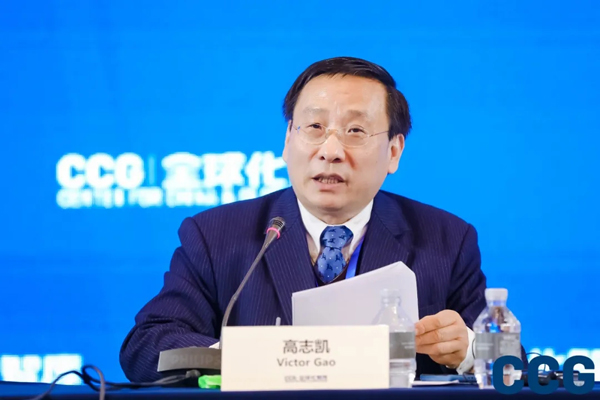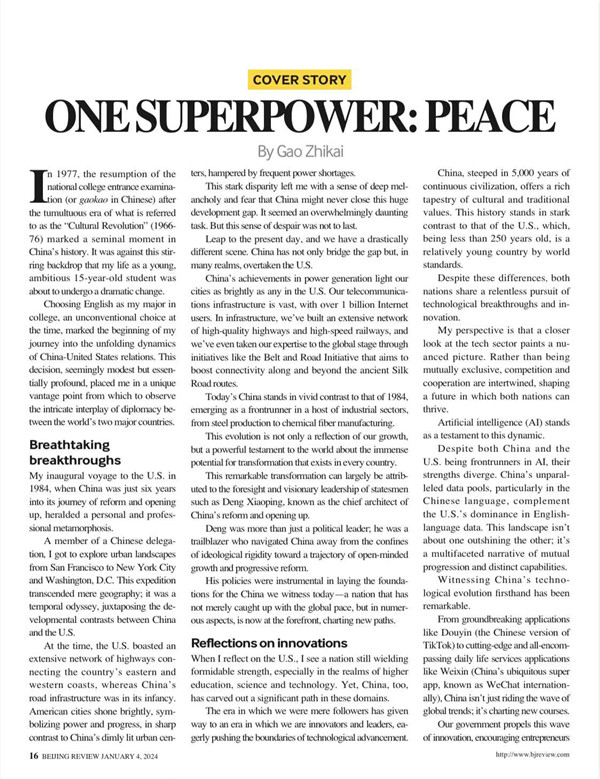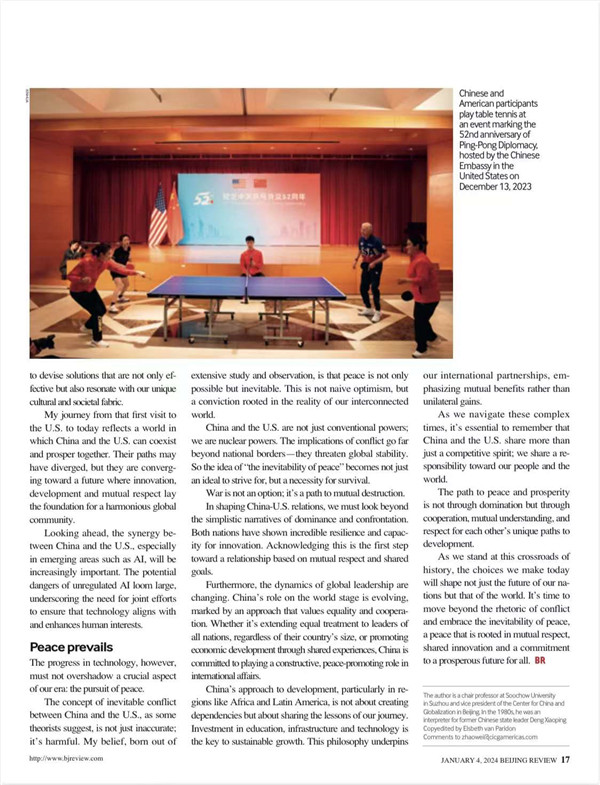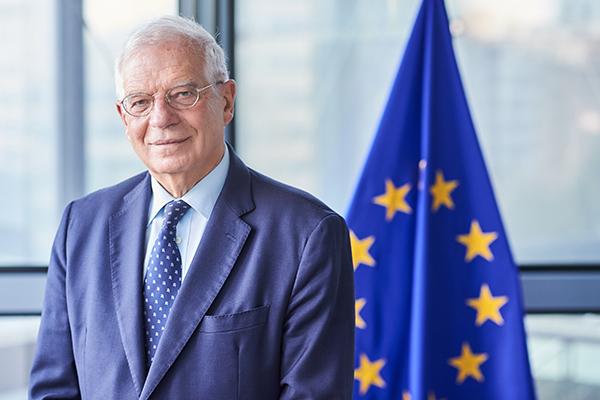One superpower: peace
January 04 , 2024By Victor Gao, vice-president of the Center for China and Globalization (CCG) .
In 1977, the resumption of the national college entrance examination (or gaokao in Chinese) after the tumultuous era of what is referred to as the “Cultural Revolution” (1966-76) marked a seminal moment in China’s history. It was against this stirring backdrop that my life as a young, ambitious 15-year-old student was about to undergo a dramatic change.
Choosing English as my major in college, an unconventional choice at the time, marked the beginning of my journey into the unfolding dynamics of China-United States relations. This decision, seemingly modest but essentially profound, placed me in a unique vantage point from which to observe the intricate interplay of diplomacy between the world’s two major countries.
Breathtaking breakthroughs
My inaugural voyage to the U.S. in 1984, when China was just six years into its journey of reform and opening up, heralded a personal and professional metamorphosis.
A member of a Chinese delegation, I got to explore urban landscapes from San Francisco to New York City and Washington, D.C. This expedition transcended mere geography; it was a temporal odyssey, juxtaposing the developmental contrasts between China and the U.S.
At the time, the U.S. boasted an extensive network of highways connecting the country’s eastern and western coasts, whereas China’s road infrastructure was in its infancy. American cities shone brightly, symbolizing power and progress, in sharp contrast to China’s dimly lit urban centers, hampered by frequent power shortages.
This stark disparity left me with a sense of deep melancholy and fear that China might never close this huge development gap. It seemed an overwhelmingly daunting task. But this sense of despair was not to last.
Leap to the present day, and we have a drastically different scene. China has not only bridge the gap but, in many realms, overtaken the U.S.
China’s achievements in power generation light our cities as brightly as any in the U.S. Our telecommunications infrastructure is vast, with over 1 billion Internet users. In infrastructure, we’ve built an extensive network of high-quality highways and high-speed railways, and we’ve even taken our expertise to the global stage through initiatives like the Belt and Road Initiative that aims to boost connectivity along and beyond the ancient Silk Road routes.
Today’s China stands in vivid contrast to that of 1984, emerging as a frontrunner in a host of industrial sectors, from steel production to chemical fiber manufacturing.
This evolution is not only a reflection of our growth, but a powerful testament to the world about the immense potential for transformation that exists in every country.
This remarkable transformation can largely be attributed to the foresight and visionary leadership of statesmen such as Deng Xiaoping, known as the chief architect of China’s reform and opening up.
Deng was more than just a political leader; he was a trailblazer who navigated China away from the confines of ideological rigidity toward a trajectory of open-minded growth and progressive reform.
His policies were instrumental in laying the foundations for the China we witness today—a nation that has not merely caught up with the global pace, but in numerous aspects, is now at the forefront, charting new paths.
Reflections on innovations
When I reflect on the U.S., I see a nation still wielding formidable strength, especially in the realms of higher education, science and technology. Yet, China, too, has carved out a significant path in these domains.
The era in which we were mere followers has given way to an era in which we are innovators and leaders, eagerly pushing the boundaries of technological advancement.
China, steeped in 5,000 years of continuous civilization, offers a rich tapestry of cultural and traditional values. This history stands in stark contrast to that of the U.S., which, being less than 250 years old, is a relatively young country by world standards.
Despite these differences, both nations share a relentless pursuit of technological breakthroughs and innovation.
My perspective is that a closer look at the tech sector paints a nuanced picture. Rather than being mutually exclusive, competition and cooperation are intertwined, shaping a future in which both nations can thrive.
Artificial intelligence (AI) stands as a testament to this dynamic.
Despite both China and the U.S. being frontrunners in AI, their strengths diverge. China’s unparalleled data pools, particularly in the Chinese language, complement the U.S.’s dominance in English-language data. This landscape isn’t about one outshining the other; it’s a multifaceted narrative of mutual progression and distinct capabilities.
Witnessing China’s technological evolution firsthand has been remarkable.
From groundbreaking applications like Douyin (the Chinese version of TikTok) to cutting-edge and all-encompassing daily life services applications like Weixin (China’s ubiquitous super app, known as WeChat internationally), China isn’t just riding the wave of global trends; it’s charting new courses.
Our government propels this wave of innovation, encouraging entrepreneurs to devise solutions that are not only effective but also resonate with our unique cultural and societal fabric.
My journey from that first visit to the U.S. to today reflects a world in which China and the U.S. can coexist and prosper together. Their paths may have diverged, but they are converging toward a future where innovation, development and mutual respect lay the foundation for a harmonious global community.
Looking ahead, the synergy between China and the U.S., especially in emerging areas such as AI, will be increasingly important. The potential dangers of unregulated AI loom large, underscoring the need for joint efforts to ensure that technology aligns with and enhances human interests.
Peace prevails
The progress in technology, however, must not overshadow a crucial aspect of our era: the pursuit of peace.
The concept of inevitable conflict between China and the U.S., as some theorists suggest, is not just inaccurate; it’s harmful. My belief, born out of extensive study and observation, is that peace is not only possible but inevitable. This is not naive optimism, but a conviction rooted in the reality of our interconnected world.
China and the U.S. are not just conventional powers; we are nuclear powers. The implications of conflict go far beyond national borders—they threaten global stability. So the idea of “the inevitability of peace” becomes not just an ideal to strive for, but a necessity for survival.
War is not an option; it’s a path to mutual destruction.
In shaping China-U.S. relations, we must look beyond the simplistic narratives of dominance and confrontation. Both nations have shown incredible resilience and capacity for innovation. Acknowledging this is the first step toward a relationship based on mutual respect and shared goals.
Furthermore, the dynamics of global leadership are changing. China’s role on the world stage is evolving, marked by an approach that values equality and cooperation. Whether it’s extending equal treatment to leaders of all nations, regardless of their country’s size, or promoting economic development through shared experiences, China is committed to playing a constructive, peace-promoting role in international affairs.
China’s approach to development, particularly in regions like Africa and Latin America, is not about creating dependencies but about sharing the lessons of our journey. Investment in education, infrastructure and technology is the key to sustainable growth. This philosophy underpins our international partnerships, emphasizing mutual benefits rather than unilateral gains.
As we navigate these complex times, it’s essential to remember that China and the U.S. share more than just a competitive spirit; we share a responsibility toward our people and the world.
The path to peace and prosperity is not through domination but through cooperation, mutual understanding, and respect for each other’s unique paths to development.
As we stand at this crossroads of history, the choices we make today will shape not just the future of our nations but that of the world. It’s time to move beyond the rhetoric of conflict and embrace the inevitability of peace, a peace that is rooted in mutual respect, shared innovation and a commitment to a prosperous future for all.
From Beijing Review, 2024-1-4
Topical News See more









